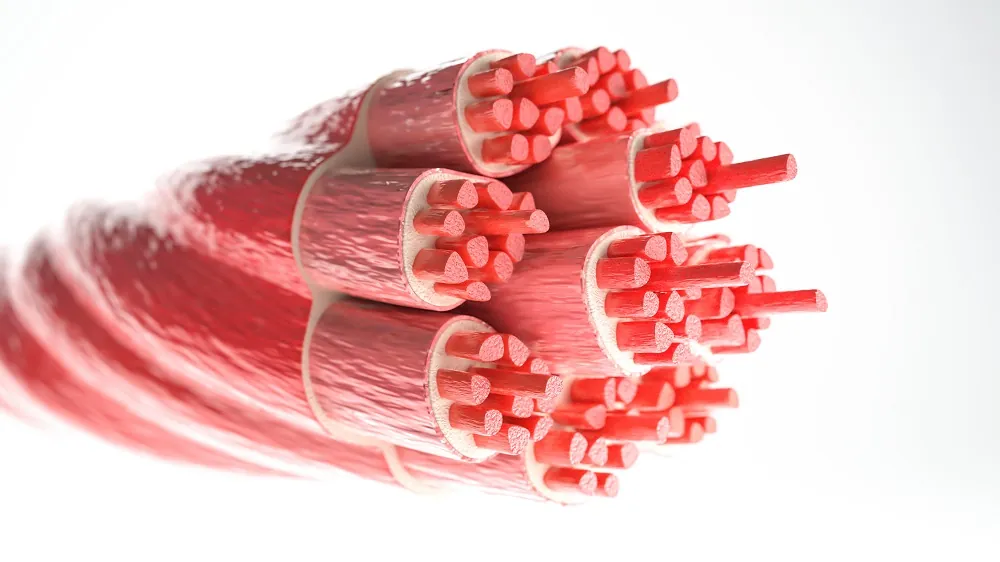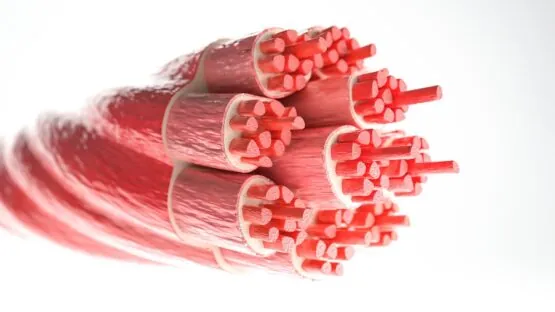With an in-depth examination tool in hand, researchers publishing in Aging have done a preliminary examination of the muscle protein differences between younger and older people and how older people’s proteins change with exercise.
The power to take a close look
This paper begins with a discussion of proteomics, the science of analyzing what proteins a tissue expresses. These researchers hold that proteomics is naturally more representative of physical processes in tissues than other -omics approaches, such as genomics [1]. However, analyzing muscle tissue in this way is tricky, as common techniques that do not accurately capture poorly soluble proteins will not paint an accurate picture [2].
A method that uses magnetic nanoparticles to separate proteins has recently been developed [3]. This process yields considerably more information than previous processes, particularly about proteins that have very little expression. The researchers used this technique to investigate how proteins change with aging and with resistance exercise.
Looking for resistance training evidence
Five women with an average age of 22 and six people with an average age of 56 had their skeletal muscle proteins analyzed at the beginning of this study. The two groups did not have significant differences in body mass or body fat. The older group underwent an 8-week resistance training exercise, after which their proteins were analyzed again.
On average, the participants had 2,611 proteins that were specifically related to the part of muscle tissue that performs the basic contractile function (MyoF proteins) along with another 5,645 that did not (non-MyoF proteins). Before intervention, older people tended to have fewer detectable MyoF proteins and more non-MyoF proteins before resistance exercise, although these findings did not reach statistical significance. The researchers also analyzed existing databases and related the functions for which these proteins were responsible, including signaling, mitochondrial function, RNA handling, and the folding and maintenance of other proteins. The non-MyoF fraction had 2,091 proteins that were found nowhere in MyoF, while MyoF had 141 proteins exclusive to it.
The researchers then started looking for which proteins were most affected by resistance exercise and by aging. A protein called titin has been the subject of quite a bit of research interest [4], but this paper found no significant changes with exercise or aging. While there were some differences between the protein isoforms of younger and older people, these isoforms were unaffected by exercise. Instead, resistance training affected the levels of 13 MyoF proteins and 64 non-MyoF proteins in these participants, although this was not found to strongly affect any particular pathway.
Proteins that were related to maintenance (proteostasis) were far more abundant in the MyoF fractions of younger than older people, although this situation was reversed for the non-MyoF fraction. Resistance training slightly increased the abundance of some of these proteins in both types of tissues in older people. Three different heat shock proteins, which are related to muscle regulation, were reduced in older people, as were many proteins related to mitochondrial function.
More examination needed
Discouragingly, the researchers found few significant changes to the proteome with resistance exercise, and most of these changes did not seem to be directly related to aging. They did note, however, that resistance exercise promotes muscle-building proteins, perhaps explaining why it has modest effectiveness in staving off age-related muscle loss (sarcopenia).
This was a small pilot study with only 11 total participants. As these researchers note, considerably more in-depth studies will have to be conducted to determine the effectiveness of interventions that affect proteins with aging. While the new tool is very informative, each person’s protein quantities are different, and the only way to control for individual effects is through large-scale trials.
Literature
[1] Pan, C., Kumar, C., Bohl, S., Klingmueller, U., & Mann, M. (2009). Comparative proteomic phenotyping of cell lines and primary cells to assess preservation of cell type-specific functions. Molecular & Cellular Proteomics, 8(3), 443-450.
[2] Roberts, M. D., Young, K. C., Fox, C. D., Vann, C. G., Roberson, P. A., Osburn, S. C., … & Kavazis, A. N. (2020). An optimized procedure for isolation of rodent and human skeletal muscle sarcoplasmic and myofibrillar proteins. Journal of Biological Methods, 7(1).
[3] Blume, J. E., Manning, W. C., Troiano, G., Hornburg, D., Figa, M., Hesterberg, L., … & Farokhzad, O. C. (2020). Rapid, deep and precise profiling of the plasma proteome with multi-nanoparticle protein corona. Nature communications, 11(1), 3662.
[4] Nishikawa, K., Lindstedt, S. L., Hessel, A., & Mishra, D. (2020). N2A titin: signaling hub and mechanical switch in skeletal muscle. International Journal of Molecular Sciences, 21(11), 3974.





